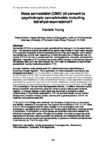Does cannabidiol (CBD) oil convert to psychotropic cannabinoids including tetrahydrocannabinol?
| dc.contributor.author | Young, D. | |
| dc.date.accessioned | 2021-12-24T17:23:00Z | |
| dc.date.available | 2021-12-24T17:23:00Z | |
| dc.date.issued | 2021 | |
| dc.identifier.citation |
Young, D. (2021) 'Does cannabidiol (CBD) oil convert to psychotropic cannabinoids including tetrahydrocannabinol?', The Plymouth Student Scientist, 14(2), pp. 191-224. | en_US |
| dc.identifier.uri | http://hdl.handle.net/10026.1/18504 | |
| dc.description.abstract |
Cannabidiol (CBD) is a non-psychotropic cannabinoid that belongs to the Cannabis Sativa L plant. This naturally occurring cannabinoid has gained huge interest in recent years because of the potential therapeutic and pharmacological effects it has upon ingestion and inhalation. Cannabidiol has not only been regarded as a medicinal product but is widely sold over the counter (OTC) in the form of concentrated oils, food supplements, cosmetics, and electronic cigarettes. Regulation of OTC products has proven difficult because of the narcotic nature of the cannabis plant and it has been advised that CBD might be degraded into psychotropic cannabinoids, namely tetrahydrocannabinol (THC). In current literature, orally administered CBD tablets have shown high incidence of drowsiness through ingestion. This is particularly of interest because in a previous study comparing the effects of Δ9-THC and CBD in a sleep-wake cycle, it was found that THC promoted sleep whereas CBD caused wake-inducing effects perhaps suggesting evidence of THC in OTC products. This project aims to carefully review studies that have investigated degradants and metabolites of CBD and summarise findings of CBD degradation processes, specifically the results of in-vivo and in-vitro studies. Additionally, method development and instrumentation efficiency will be explored for the separation and quantification of CBD and THC to investigate if this can affect the degradation kinetics. To achieve these aims various literature searches were performed using key words to access relevant peer reviewed research. A thorough analysis of each paper was performed to provide an in-depth understanding of the potential degradation of CBD oil and other details such as method development, extraction efficacy, product recovery and a general picture of CBD in the medicinal and consumer industries. In vitro and in vivo findings were presented that showcase a huge amount of controversy and highlight weakness in the argument that supports the conversion of CBD to THC. Many of the in-vitro investigations did not report changes to the psychological and motor functioning of participants and in those that did, the data was limited due to the small number of participants, no comparison to control groups and potentially inaccurate feedback that should be interpreted with caution. Although controversial, the evidence supporting acidic degradation is still viable, therefore product contamination and mislabeling has also been considered as well as variation and inconsistencies in production methods and biochemical influences such as ‘The Entourage Effect’. | en_US |
| dc.language.iso | en | en_US |
| dc.publisher | University of Plymouth | en_US |
| dc.rights | Attribution 3.0 United States | * |
| dc.rights.uri | http://creativecommons.org/licenses/by/3.0/us/ | * |
| dc.subject | Cannabidiol | en_US |
| dc.subject | Tetrahydrocannabinol | en_US |
| dc.subject | Entourage effect | en_US |
| dc.subject | Biochemistry | en_US |
| dc.subject | Pharmacokinetics | en_US |
| dc.subject | Cyclisation | en_US |
| dc.subject | Acid-degradation | en_US |
| dc.title | Does cannabidiol (CBD) oil convert to psychotropic cannabinoids including tetrahydrocannabinol? | en_US |
| dc.type | Article | en_US |
| plymouth.issue | 2 | |
| plymouth.volume | 14 | |
| plymouth.journal | The Plymouth Student Scientist |



